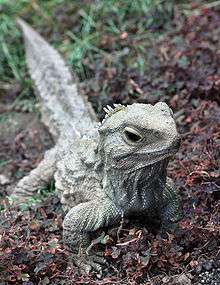Clevosaurus
Clevosaurus (CLEE-vo-SORE-us) (meaning "Gloucester lizard") is an extinct genus of rhynchocephalian reptile from the Triassic and the Jurassic periods of Nova Scotia, Great Britain, (C. bairdi), Yunnan (C. mcgilli) and Brazil (C. hadroprodon)[3]. Clevosaurus was extremely similar to the modern tuatara in almost every way; the two genera differ in only certain features of the teeth and skull anatomies, as well as size. Clevosaurus was smaller than the modern tuatara. Clevosaurus possibly ate plants as well as insects, as suggested by the form of the teeth. Fossils of Clevosaurus, as well as other sphenodontians, early mammals and dinosaurs have been found in ancient cave systems of Great Britain. Clevosaurus is now believed to have had Pangaean distribution.[4] In regards to its Pangaean distribution, C. hadroprodon is the oldest record of a sphenodontian from Gondwana.[5]
| Clevosaurus | |
|---|---|
| Skulls of C. brasiliensis | |
| Scientific classification | |
| Kingdom: | Animalia |
| Phylum: | Chordata |
| Class: | Reptilia |
| Order: | Rhynchocephalia |
| Family: | Clevosauridae |
| Genus: | Clevosaurus Swinton, 1939 |
| Named Species | |
| |
| Synonyms | |
| |
Discoveries
Some fossils from South America (into Geopark Paleorrota) found in 2006 represent a new species of Clevosaurus (C. brasiliensis).[6] A new species has been named Clevosaurus sectumsemper after the spell from Harry Potter.[7][8]
In August 2019, Clevosaurus hadroprodon, thus far the oldest fossil of sphenodontians in former Gondwana, was discovered.[5]
Species
Below is a cladogram of the relationships within Clevosauridae based on the phylogenetic analysis of Hsiou et al. (2015):[9]
| Clevosauridae |
| ||||||||||||||||||||||||||||||||||||||||||
"Clevosaurus" latidens was recovered outside of Clevosauridae, as the sister taxon of Opisthodontia.[9] It was subsequently assigned to a new genus, Fraserosphenodon, in 2018.[10]
Notes
- Emily Keeble; David I. Whiteside; Michael J. Benton (2018). "The terrestrial fauna of the Late Triassic Pant-y-ffynnon Quarry fissures, South Wales, UK and a new species of Clevosaurus (Lepidosauria: Rhynchocephalia)". Proceedings of the Geologists' Association. in press (2): 99–119. doi:10.1016/j.pgeola.2017.11.001. hdl:1983/5afdc677-3ea0-4519-813d-6052ef8370ec.
- Säilä, Laura K. (2005). "A new species of the sphenodontian reptile Clevosaurus from the Lower Jurassic of South Wales". Palaeontology. 48 (4): 817–831. doi:10.1111/j.1475-4983.2005.00486.x.
- "A New Clevosaurid from the Triassic (Carnian) of Brazil and the Rise of Sphenodontians in Gondwana".
- Sues, H. D.; Reisz, R. (1995). "First record of the early mesozoic sphenodontian clevosaurus (lepidosauria: rhynchocephalia) from the southern hemisphere". Journal of Paleontology. 69 (1): 123–126. doi:10.1017/s0022336000026974.
- "A new sphenodontian from Brazil is the oldest record of the group in Gondwana". phys.org. Retrieved 2019-08-15.
- Bonaparte, J. F.; Sues, H. D. (2006). "A new species of clevosaurus (lepidosauria: rhynchocephalia) from the upper Triassic of Rio Grande do Sul, Brazil". Palaeontology. 49 (1): 917–923. doi:10.1111/j.1475-4983.2006.00568.x.
- "Harry Potter sectumsempra spell inspires lizard name". BBC News. 4 June 2015.
- Klein, Catherine G.; Whiteside, David I.; de Lucas, Victor Selles; Viegas, Pedro A.; Benton, Michael J. (2015). "A distinctive Late Triassic microvertebrate fissure fauna and a new species of Clevosaurus (Lepidosauria: Rhynchocephalia) from Woodleaze Quarry, Gloucestershire, UK". Proceedings of the Geologists' Association. 126 (3): 402–416. doi:10.1016/j.pgeola.2015.05.003.
- Annie Schmaltz Hsiou; Marco Aurélio Gallo De França; Jorge Ferigolo (2015). "New Data on the Clevosaurus (Sphenodontia: Clevosauridae) from the Upper Triassic of Southern Brazil". PLoS ONE. 10 (9): e0137523. doi:10.1371/journal.pone.0137523. PMC 4565693. PMID 26355294.
- Jorge A. Herrera-Flores; Thomas L. Stubbs; Armin Elsler; Michael J. Benton (2018). "Taxonomic reassessment of Clevosaurus latidens Fraser, 1993 (Lepidosauria, Rhynchocephalia) and rhynchocephalian phylogeny based on parsimony and Bayesian inference". Journal of Paleontology. Online edition (4): 734–742. doi:10.1017/jpa.2017.136.
References
- Paleofile
- Gill PG, Säilä LK, Corfe IJ, Challands TJ, Williams M, Clemens WA (2006). The fauna and palaeoenvironment of St. Brides Island: Evidence from the lower Jurassic fissure fills of South Wales. In Barrett PM, Evans SE (eds.). Ninth international symposium on Mesozoic terrestrial ecosystems and biota. pp 48−51. London: Natural History Museum.
- Jones MEH (2006) The Early Jurassic clevosaurs from China (Diapsida: Lepidosauria). Natl Mus Nat Hist Sci Bull, 37:548–562.
- Jones MEH (2009). Dentary tooth shape in Sphenodon and its fossil relatives (Diapsida: Lepidosauria: Rhynchocephalia). In Koppe T, Meyer G, Alt KW, (eds). Interdisciplinary Dental Morphology, Frontiers of Oral Biology (vol 13). Greifswald, Germany; Karger. 9–15.
